Content of the article

In order to find out the type of your device, the browser sends a string, also known as User-Agent, to the website. WEDEX will tell you how you can use User-Agent to ensure the correct operation of your website.
What is a User-Agent?
When we open a website, depending on the device and browser, the site may have a different appearance. In order for the site to «understand» how exactly it should look, User-Agent is used.
User-Agent is one of the HTTP request headers that is responsible for identifying the browser, application, or operating system that is connecting to the website. In general, User-Agent can also be understood as browsers, email clients, and download managers, but in this article, we are talking about the HTTP header.
User agents are used to identify device types and OSes not only for users but also for bots and crawlers. Among them are Googlebot and Google AdSense search robots.
How can I use User-Agent?
User-Agent is an indispensable tool for several areas at once. SEO specialists, marketers, and web developers alike use user agents to test different parts of a website.
The use of different User-Agents can help to identify problems with certain browsers and/or operating systems that are present on the website. As practice shows, not all web pages work correctly on different browsers, which can directly affect the user experience and SEO optimization of the site.
After all, User-Agent is a tool for testing website performance that will help you identify most of the problems associated with responsive layout and the correct operation of the same APIs.
How can you use a custom agent in SEO?
SEO specialists use User-Agent to find problems no less than web developers. But while web developers are looking for errors in the display or logic of the site, an SEO specialist is working on optimizing the web resource. Here are some of the main reasons for using User-Agent in SEO:
- Violation of search engine rules. The use of User-Agents such as Googlebot will help to understand the existence of problems with content masking, i.e., the website providing information to the user and search engines that violates the rules of search engines. Such actions are often the result of criminal attacks on the site and can lead to a deterioration in page rankings.
- Compatibility. User-Agent allows you to study the compatibility of your website with different systems, browsers, and devices. The compatibility and correct operation of the site greatly affect SEO.
- User experience. By understanding how a particular content is displayed on different systems, you can create an approach that will improve not only the quality of the content but also the user experience.
- Search for website problems. Changing the User-Agent can help identify website issues related to a specific browser or OS.
How do I change the User-Agent and what can it do to me?
The process of changing the User-Agent is called… Spoofing. The term seems to refer to something not very legal, but there is no crime in it. The derivative name for this process in English is spoofing.
The User-Agent is changed when the browser or client (not the user, but the program) sends the appropriate HTTP header to the website. The use of different User-Agents is commonplace for specialists in various fields, so changing it will not lead to any negative changes.
Replacing User-Agent in Google Chrome and Edge
To get to the coveted menu item, you need to perform the following manipulations:
- Right-click on a free space on the site – select «View code»;
- In the window with the code, find three vertical points (top right);
- Select the More tools item in the menu and the Network conditions sub-item.
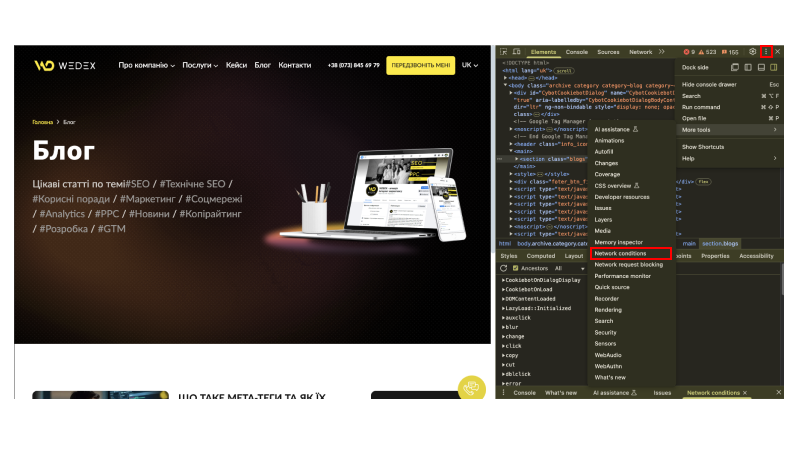
Among the other tabs of the code review tool, you should see the Network conditions tab. In this tab, find the «User agent» item and uncheck the «Use browser default» box. After that, the «Custom» item will become available, which will open access to changing the User-Agent header. Choose the required type of browser or device.
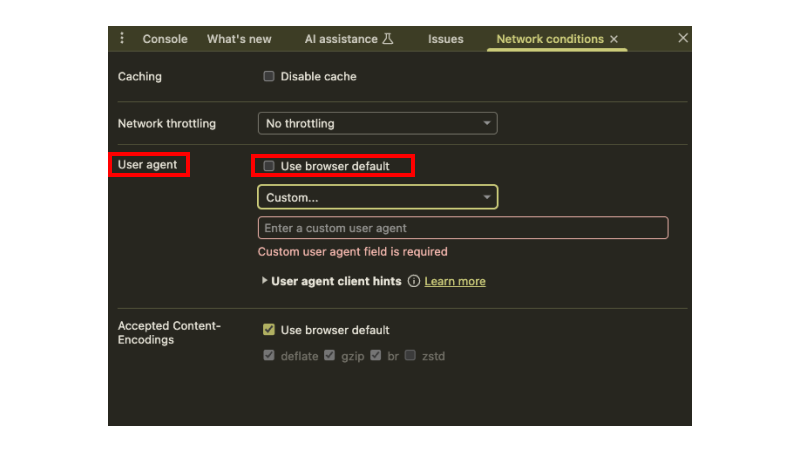
If you don’t see the one you need among the proposed options, you can enter a custom Googlebot agent in the field below. The text will look like this:
Mozilla/5.0 (compatible; Googlebot/2.1; +http://www.google.com/bot.html)
Extension to change User-Agent
There are also external tools to change the user agent, such as a Google Chrome extension. It is called User-Agent Switcher and Manager and allows you to change the agent without searching for the corresponding menu item in code view.
Extensions of this type make sense, but you should take into account the following nuances:
- extensions can be unstable and make changes to the appearance of websites on their own;
- extensions have the ability to load browsers, so if you already have several powerful extensions running in parallel, this can cause problems in the application.
Changing the User-Agent with Google’s built-in tools is the most reliable option.
How to change User-Agent in Mozilla Firefox?
Although Firefox supports the use of different User-Agents, activating them can be difficult. We offer the following solutions to this problem.
Using extensions for Mozilla Firefox
As is the case with Google Chrome, Firefox supports extensions for changing the User-Agent. The familiar User-Agent Switcher and Manager extension is also available for this browser.
User-Agent Switcher Firefox is a somewhat limited in functionality, but also an effective extension. The main drawback of this extension is the small number of available User-Agents.
Create a User-Agent manually
If extensions are not what you are interested in, we will still demonstrate how to create a User-Agent in Firefox manually. So:
-
- Enter about:config in the search bar and navigate using Enter or the search button.
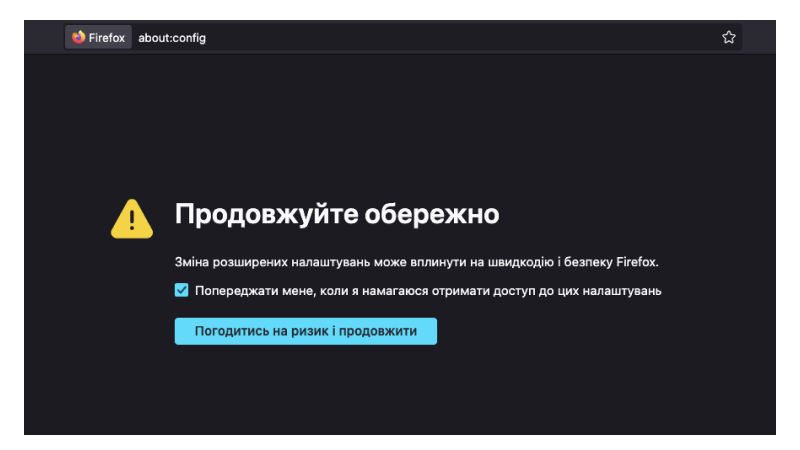
-
- Accept the warning and click «Accept the risk and continue».
- In the window titled «Search for a setting by name», enter the string general.useragent.override. Firefox will prompt you to create a new setting with the same name. Select the String option and then click on the «+» (plus) sign at the end.
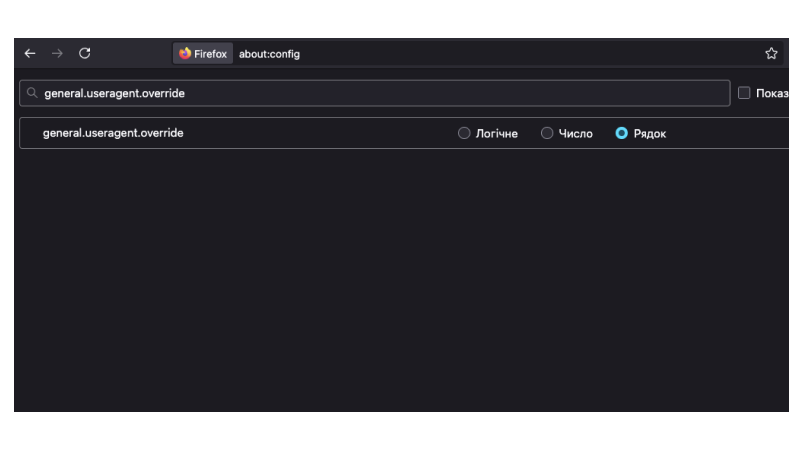
-
- A new setting will be created with an empty space to add the User-Agent string. Follow this link and find the required user agent. Copy it and paste it into the same empty space for the string.
- Click Save.
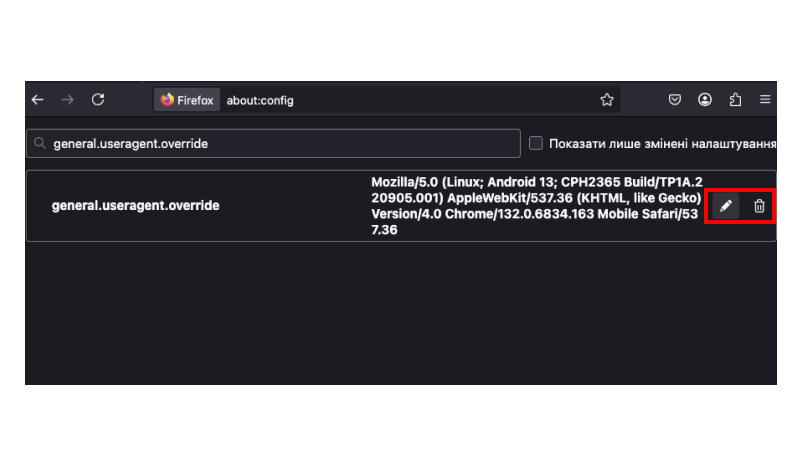
That’s it! Now there is a specific User-Agent setting for Firefox and all pages in the browser will look like the one you set. You can create other settings strings for different user agents.
To reset the User-Agent settings in Firefox, just delete the line of the corresponding setting. To do this, click the trash can icon next to it.
Changing the User-Agent in Safari
To change the User-Agent in an Apple browser, follow these steps:
- Go to Settings and select the «Add-ons» or «Advanced» tab.
- At the bottom, there will be an option called “Show features for web developers. Put a check mark against it.
- Close Settings and go to any site. In the top status bar, select the Development item.
- There is a User Agent item in the menu. When you click on it, a menu with the User-Agent selection appears.
The list of available User-Agents in Safari is small, but, like in Google Chrome, you can create your own agent.
Instead of conclusions
User-Agent is a useful tool for analyzing the front-end of a website and SEO optimization. User-Agent is actively used to find any problems, including user experience and website adaptation for different platforms. User Agent is one of the most effective ways to test a website that does not require additional financial investments. Moreover, it is completely safe for your website.
On the other hand, you should remember that User-Agent only offers emulation of other devices and browsers. For real testing, you should still use different types of devices and software. However, User-Agent will still help you detect most errors.






 30/05/2025
30/05/2025  1924
1924



